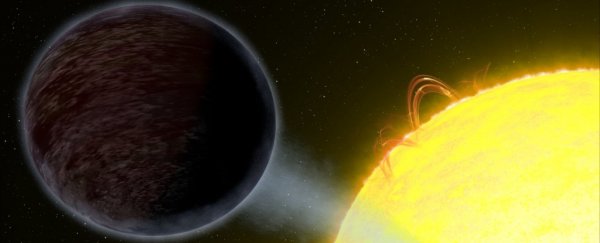Exoplanet WASP-12b does not seem like a good place to go for a visit. New research has found that most of the light that goes towards it doesn't come out again, making the gas giant pitch black.
The planet, discovered in 2008, is just 1400 light-years from Earth. It's become one of the most studied outside our solar system, and we know a fair bit about it.
We know that it's what is known as a "hot Jupiter", a gigantic gaseous planet 40 times more massive than Jupiter that orbits extremely close to its host star. In fact, it's so close that it completes an orbit (one WASP-12b year) in just under one Earth day, and has been pulled by gravity into an egg shape.
At only 3.2 million kilometres (2.1 million miles) from its star, 46 times smaller than the average distance between the sun and Earth, WASP-12b is tidally locked. Its rotation matches its orbit. This means one side is always facing its star, perpetually in day, and the other is always facing away, perpetually in night.
(You can observe this phenomenon in the Earth and Moon, too. It's why we only ever see one side of the moon.)
And, researchers have found, it's really, really black. It absorbs at least 94 percent of the light falling into its atmosphere, which means it's darker than fresh asphalt.
They used the Hubble Space Telescope's spectrograph to measure how much light the planet reflects, a measurement called the albedo. WASP-12b's albedo was just 0.064 at most - two times less reflective than Earth's moon, which has an albedo of 0.12.
"We did not expect to find such a dark exoplanet," said lead researcher Taylor Bell of McGill University and the Institute for Research on Exoplanets in Canada. "Most hot Jupiters reflect about 40 percent of starlight."
On other dark Jupiters, it's thought that clouds in the atmosphere might stop light from escaping, but WASP-12b is too hot on its day side for clouds to form.
In fact, at 2600 degrees Celsius (4700 degrees Fahrenheit) it's so hot that hydrogen molecules are broken down into atomic hydrogen, causing the atmosphere on that side of the planet to behave more like that of a low-mass star.
This, the team believes, is what causes the planet's low albedo.
But WASP-12b's reverse side, where it's perpetually night, is different. It's over 1000 degrees Celsius (2000 degrees Fahrenheit) cooler, which allows water vapour and clouds to form. This is consistent with previous spectral measurements taken of WASP-12b, which found water in its atmosphere.
WASP-12b may reflect very little light, but that doesn't mean it's completely dark. Because of its extreme heat, it glows red, like molten metal.
"This new Hubble research further demonstrates the vast diversity among the strange population of hot Jupiters," Bell said.
"You can have planets like WASP-12b that are 4,600 degrees Fahrenheit and some that are 2,200 degrees Fahrenheit, and they're both called hot Jupiters."
WASP-12b is also doomed. Its proximity to its star means that the star is close enough to pull away its atmosphere. Scientists estimate that the planet may just have another 10 million years before it's completely devoured.
The research has been published in the journal The Astrophysical Journal Letters.
